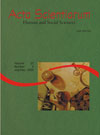Maringá and Higher Education institutions: new spaces for concentration and exclusion
Abstract
This article discusses the transformations occurring in the urban space of Maringá, emphasizing the changes occurring since the implementation of Higher Education institutions. The study is based on indicator of the Brazilian Institute of Geography and Statistics and of the National Institute of Studies and Research, as well as on a bibliographical review which discusses the expansion of higher education, the urban recentralization in Brazil and in the State of Paraná, and the urban space. As these institutions became more numerous, Maringá consolidated itself as an educational and cultural center, causing deep changes in the (re)production of urban space and its respective contents. As a consequence, the city began attracting an increasing number of university candidates and academics from other cities in Paraná and even from other Brazilian states. Those students made use of housing, services, infra-structure, commerce, leisure, and thus, they caused significant economical, social, political and geo-spatial transformations.Downloads
Download data is not yet available.
Published
2007-09-28
How to Cite
Mota, A. A. da. (2007). Maringá and Higher Education institutions: new spaces for concentration and exclusion. Acta Scientiarum. Human and Social Sciences, 28(2), 249-255. https://doi.org/10.4025/actascihumansoc.v28i2.156
Issue
Section
Geography
DECLARATION OF ORIGINALITY AND COPYRIGHTS
I Declare that current article is original and has not been submitted for publication, in part or in whole, to any other national or international journal.
The copyrights belong exclusively to the authors. Published content is licensed under Creative Commons Attribution 4.0 (CC BY 4.0) guidelines, which allows sharing (copy and distribution of the material in any medium or format) and adaptation (remix, transform, and build upon the material) for any purpose, even commercially, under the terms of attribution.
Read this link for further information on how to use CC BY 4.0 properly.























